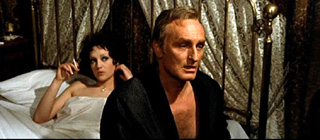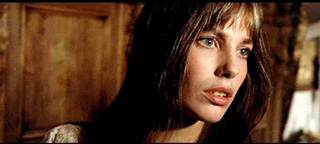Marking another release of a film intended for the rumored GIALLO COLLECTION VOL. 2, Antonio Margheriti’s SEVEN DEATHS IN THE CAT’S EYE barely passes as a giallo. The late great Margheriti himself probably wouldn’t appreciate the film being labeled as such, as it’s another of his fabulous peeks into the “old dark house” Gothic horror genre with a few trappings of the “yellow thriller” films. Whichever category the film falls into, it’s one of Margheriti’s most entertaining productions and an under-appreciated gem restored by Blue Underground.
 Lovely
young Corringa is expelled from her Catholic boarding school and sent home to
the family estate, where all is not well in Denmark. The secluded castle is
crumbling, and its owner, Mary, is desperate for money to keep it in her possession;
Corringa’s mother, Alicia, refuses to lend any of the inheritance she
received from her late husband; pompous cousin James stomps through the castle
with as much attitude as the family’s pet cat; French tutor Suzanne implies
she knows more about the family’s skeletons than she should; and in-house
preacher Father Robertson may be hiding a secret of his own. Amidst all this
unrest and mystery, a mystery killer smothers Alicia in her bed and soon begins
picking off the rest of the houseguests one by one.
Lovely
young Corringa is expelled from her Catholic boarding school and sent home to
the family estate, where all is not well in Denmark. The secluded castle is
crumbling, and its owner, Mary, is desperate for money to keep it in her possession;
Corringa’s mother, Alicia, refuses to lend any of the inheritance she
received from her late husband; pompous cousin James stomps through the castle
with as much attitude as the family’s pet cat; French tutor Suzanne implies
she knows more about the family’s skeletons than she should; and in-house
preacher Father Robertson may be hiding a secret of his own. Amidst all this
unrest and mystery, a mystery killer smothers Alicia in her bed and soon begins
picking off the rest of the houseguests one by one.
 The
opening sequence, of a freshly murdered corpse being hurled down a staircase
and devoured by a swarm of rats as a sinister fluffy cat oversees all, is a
typical jarring Margheriti move, and is a perfect set-up for this surprisingly
gory little number from Italy’s master of Gothic horror (CASTLE OF BLOOD,
VIRGIN OF NUREMBERG). Rather than a horror film, this is much like an Agatha
Christie whodunit, with all the red herring characters in place, biting dialogue
thrown between them, and much looking over one’s shoulder to ensure survival.
The thick atmosphere of the spooky castle couldn’t be cut with a knife,
and definitely contributes to the weird success of this almost schizophrenic
film. One moment it’s a supernatural tale of family curses, the next the
threat is a human one and the suspects numerous. Margheriti delivers a number
of memorable moments, in addition to the wonderful opening: Corringa accidentally
throws her Bible into a blazing fire in an ominous sequence; almost
subliminal edits of an ape peering out of castle windows, and later seen locked
in a cage; Corringa ventures into a hidden passageway to discover the rat’s
dinner and be terrorized by bats (similar to FLESH FOR FRANKENSTEIN the same
year, which Margheriti claims to have directed); the venomous family dinner
scene; and all sorts of random scenarios thrown into the film, including a ghoulish
dream sequence, the mysterious family cat with its own agenda, several sex scenes,
a goofy subplot surrounding a captive gorilla, and a killer twist ending! Never
really scary, SEVEN DEATHS IN THE CAT’S EYE is still incredibly entertaining
and many times better than Margheriti’s other 70s horror films (WEB OF
THE SPIDER, KILLER FISH).
The
opening sequence, of a freshly murdered corpse being hurled down a staircase
and devoured by a swarm of rats as a sinister fluffy cat oversees all, is a
typical jarring Margheriti move, and is a perfect set-up for this surprisingly
gory little number from Italy’s master of Gothic horror (CASTLE OF BLOOD,
VIRGIN OF NUREMBERG). Rather than a horror film, this is much like an Agatha
Christie whodunit, with all the red herring characters in place, biting dialogue
thrown between them, and much looking over one’s shoulder to ensure survival.
The thick atmosphere of the spooky castle couldn’t be cut with a knife,
and definitely contributes to the weird success of this almost schizophrenic
film. One moment it’s a supernatural tale of family curses, the next the
threat is a human one and the suspects numerous. Margheriti delivers a number
of memorable moments, in addition to the wonderful opening: Corringa accidentally
throws her Bible into a blazing fire in an ominous sequence; almost
subliminal edits of an ape peering out of castle windows, and later seen locked
in a cage; Corringa ventures into a hidden passageway to discover the rat’s
dinner and be terrorized by bats (similar to FLESH FOR FRANKENSTEIN the same
year, which Margheriti claims to have directed); the venomous family dinner
scene; and all sorts of random scenarios thrown into the film, including a ghoulish
dream sequence, the mysterious family cat with its own agenda, several sex scenes,
a goofy subplot surrounding a captive gorilla, and a killer twist ending! Never
really scary, SEVEN DEATHS IN THE CAT’S EYE is still incredibly entertaining
and many times better than Margheriti’s other 70s horror films (WEB OF
THE SPIDER, KILLER FISH).
 French
model turned actress Jane Birkin is an odd choice for the lead in this film,
but she was known for appearing in bizarre vehicles (BLOW-UP, WONDERWALL, among
others) and seems to enjoy basically playing the boring ingénue role.
Serge Gainsbourg, her one-time husband and singing partner (their sexually provocative
“Je t’aime mai non plus” was banned from French radio), plays
a police inspector, but the two share little screen time together. What a waste!
German character actor Anton Diffring (CIRCUS OF HORRORS) co-stars in a semi-villainous
role as the family doctor, and even indulges in some almost-nudity and an awkward
failed sex scene. Italian Peter Lorre look-alike Luciano Pigozzi appears as
coach driver Angus in a few scenes, Fulci favorite Venantino Venantini (CITY
OF THE LIVING DEAD) plays Father Robertson in a throwaway role.
French
model turned actress Jane Birkin is an odd choice for the lead in this film,
but she was known for appearing in bizarre vehicles (BLOW-UP, WONDERWALL, among
others) and seems to enjoy basically playing the boring ingénue role.
Serge Gainsbourg, her one-time husband and singing partner (their sexually provocative
“Je t’aime mai non plus” was banned from French radio), plays
a police inspector, but the two share little screen time together. What a waste!
German character actor Anton Diffring (CIRCUS OF HORRORS) co-stars in a semi-villainous
role as the family doctor, and even indulges in some almost-nudity and an awkward
failed sex scene. Italian Peter Lorre look-alike Luciano Pigozzi appears as
coach driver Angus in a few scenes, Fulci favorite Venantino Venantini (CITY
OF THE LIVING DEAD) plays Father Robertson in a throwaway role.
Blue Underground’s anamorphically enhanced 2.35:1 widescreen transfer of SEVEN DEATHS IN THE CAT’S EYE is doubtlessly the best the film has ever looked, including its theatrical engagements! Some very strange extreme close-ups in the opening scene between Birkin and Pigozzi appear incredibly grainy, but the rest of the film is stunningly gorgeous. Margheriti usually worked better in black and white, but his Scope photography on this film is superbly pleasing. It’s hard to imagine anyone sitting through, let alone enjoying, a fullscreen version of the film, as every inch of the frame is used to perfection. The transfer is full of solid blacks (look at Anton Diffring’s suit throughout), strong color restoration, including some lovely gel lighting and the picturesque set and costume design, and sharp detail overcoming the very faint grain present during the presentation. The mono English audio, however, is a tad quiet during some of the dialogue scenes; Riz Ortolani’s excellent score comes across beautifully.
 No
trailer here, but an interview with co-writer Giovanni Simonelli more than suffices.
Simonelli was one of the original writers of giallo novels, and discusses how
he graduated from these publications to screenwriting for peplums, working with
Margheriti on several films, and memories of the cast. Even more fascinating
is rare footage tacked onto the end of the late Margheriti explaining the reason
why he created the pseudonym “Anthony M. Dawson” (which looks to
be from the same interview session which was used for Image’s CANNIBAL
APOCALYPSE). It’s too bad that Jane Birkin wasn’t interviewed, but
it’s questionable whether she would want to revisit this less-than-stellar
moment in her career. Check out her website at www.janebirkin.net!
(Casey
Scott)
No
trailer here, but an interview with co-writer Giovanni Simonelli more than suffices.
Simonelli was one of the original writers of giallo novels, and discusses how
he graduated from these publications to screenwriting for peplums, working with
Margheriti on several films, and memories of the cast. Even more fascinating
is rare footage tacked onto the end of the late Margheriti explaining the reason
why he created the pseudonym “Anthony M. Dawson” (which looks to
be from the same interview session which was used for Image’s CANNIBAL
APOCALYPSE). It’s too bad that Jane Birkin wasn’t interviewed, but
it’s questionable whether she would want to revisit this less-than-stellar
moment in her career. Check out her website at www.janebirkin.net!
(Casey
Scott)